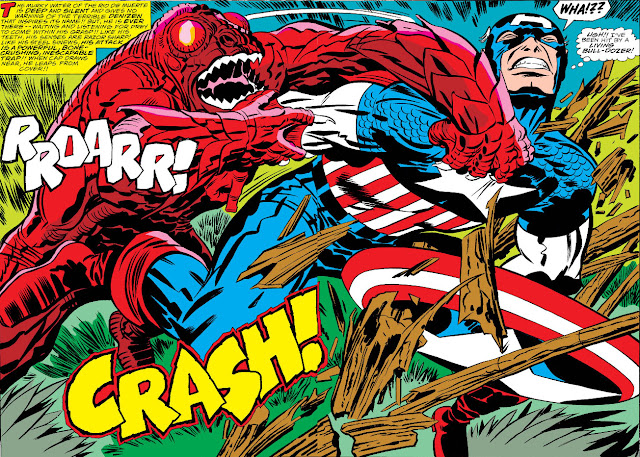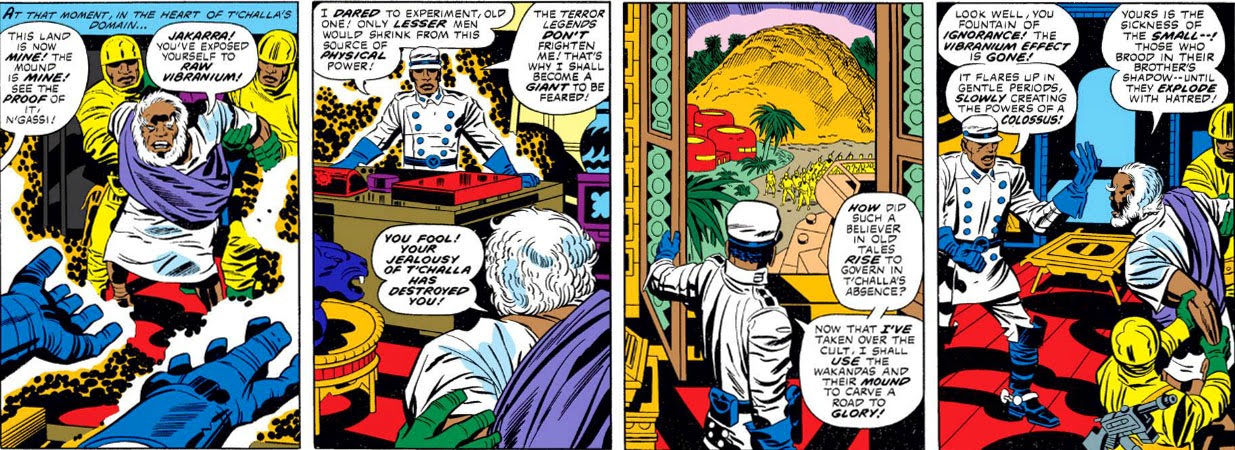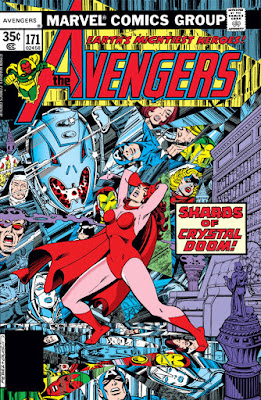| The PPC will be taking a break this week as well as January 1 to celebrate the holidays. Thanks to everyone who's stopped by and made 2017 such a fun year to dig through Marvel's classic comics and dust them off for new readers as well as those who still remember them so well. It's a pleasure sharing the memories with you! (And a happy belated birthday to Franklin Richards--still young at heart at *gulp* 49!)
Happy Holidays
from |
Saturday, December 23, 2017
We Interrupt This Blog...
Friday, December 22, 2017
Wednesday, December 20, 2017
Where Auditions The Dazzler!
 Following her 1980 introduction in the pages of Uncanny X-Men, and her guest-appearance two months later in Fantastic Four, the character known as Dazzler was rewarded with her own series a year later. It's a series I passed on, feeling a little underwhelmed at a character whose super-power boiled down to a light show that stunned those she fought, the effect's severity depending on the level of sound that was available to her to fuel her power. It also didn't bode well that her premiere issue was brimming with guest-appearances by Marvel heavy-hitters that covered all the bases for those, like myself, who might have thumbed through the issue at the store to make a quick assessment of its content. (In this case, the enticements included Spider-Man, the X-Men, and the Avengers, with a little Asgard thrown in.)
Following her 1980 introduction in the pages of Uncanny X-Men, and her guest-appearance two months later in Fantastic Four, the character known as Dazzler was rewarded with her own series a year later. It's a series I passed on, feeling a little underwhelmed at a character whose super-power boiled down to a light show that stunned those she fought, the effect's severity depending on the level of sound that was available to her to fuel her power. It also didn't bode well that her premiere issue was brimming with guest-appearances by Marvel heavy-hitters that covered all the bases for those, like myself, who might have thumbed through the issue at the store to make a quick assessment of its content. (In this case, the enticements included Spider-Man, the X-Men, and the Avengers, with a little Asgard thrown in.)During the 42-issue run of the book, the list of guest-stars would be expanded to include even more familiar faces considered to be draws for readers, such as Dr. Doom, the Hulk, the She-Hulk, Spider-Woman, Power Man and Iron Fist, and more of the X-Men, as well as the biggest gun available, Galactus. I doubt Thanos and Eternity would have been far behind.
Nor did Alison Blaire, who hoped to catch her big break as the Dazzler, seem like anyone a reader would feel like investing time in, with writer Tom DeFalco doing a virtual hail Mary and cramming the sum total of her characterization into just a few panels of brooding, making it clear she was facing an uphill struggle.
As for her power, it apparently takes Spider-Man's opinion to make it seem more interesting than it is.
Then there's the first issue's villain--the Enchantress, whose appearance definitely lends this nascent book some credibility, even if it seems laughable that the source of power that she covets will manifest in a mortal discotheque.
The circumstances that have the Dazzler and the Enchantress crossing culminate in what amounts to this premiere issue's main dramatic scene--open auditions at the club managed by Stevie Wildfire. And guess who his two choices for headliner come down to?
(Admit it: You're more than just a little curious to hear the Enchantress's singing voice--not to mention the song she chose to audition with. Maybe Annie Lennox's "I Put A Spell On You"? Or Heart's "Magic Man"? Or maybe a more up-tempo, cutting-edge arrangement of "Devil Woman." Take your pick!)
Finally, the choice is made--and the Enchantress is not happy.
This *cough* power-packed story, filled with *cough* potential, ends with the Enchantress
Good lord, I can only imagine how many of you were camping out at the comics store for the next issue after a spine-tingling cliffhanger like that.
BONUS:
Johnny Storm checks out the "Disco Dazzler"!
Tuesday, December 19, 2017
I, Magneto!
It wasn't long after artist Dave Cockrum returned for a second run on Uncanny X-Men that the title's 150th issue hit the racks--and forty pages of Claremont/Cockrum, combined with a battle royale between the X-Men and their deadliest foe, translated to an early Christmas for X-Men readers in 1981.
At this point in time, Magneto hasn't been seen nor heard from since he faced the X-Men in the heart of a volcano in the Antarctic. The X-Men's mentor, Charles Xavier, fears that Magneto is active and planning; but it's the X-Men, along with the leaders of the world's governments, who learn the extent of those plans, when Magneto makes his move--and his demands.
Show of hands: Does anyone think Magneto's audience is just going to fold?
Monday, December 18, 2017
Sisters In Seduction
Before writer/artist Walt Simonson changed the Asgardian landscape in Mighty Thor and began introducing many more characters of the realm that interacted with the principals, the self-serving sorceress known as the Enchantress appeared to have no known ties to anyone (apart from her partner in crime, the Executioner). But Simonson changed that almost immediately when he began his distinguished run as the book's regular writer, and presented the Enchantress' younger sister, Lorelei--a first appearance which makes it clear that, when it comes to a talent for manipulation and betrayal, the apple doesn't fall far from the tree.
Loki's plan for Lorelei involved using her talents to seduce Thor in order to keep him occupied while Loki schemed for power--which is exactly why he sought out the Enchantress nearly twenty years earlier (our time, that is--for a race of immortals, two decades could amount to last June).
Both the Enchantress and Lorelei would pursue the Thunder God, though the Enchantress is more drawn to Thor as a long-term prospect whereas Lorelei acts at Loki's behest and eventually tends to lose interest once her schemes have run their course. That's not to say that the Enchantress hasn't treated her men like crap, tools to exploit as a means to an end (e.g., the Black Knight, Power Man, Arkon, et al.)--on the contrary, she's been shown to be quite callous, indulging in cat-and-mouse diversions with men as a form of momentary amusement, to her victims' eternal regret.
Friday, December 15, 2017
Your Monster May Vary
During Jack Kirby's last work at Marvel Comics in the late 1970s, it seemed the protagonists in the line of comics he was working on were having their fair share of run-ins with monsters, perhaps more so than more readers were used to seeing crop up. Monsters were generally par for the course in the comics being cranked out in the late '50s and early '60s, when the monster du jour would menace the entire planet until it came up against a clever and resourceful human who discovered a way to either destroy or banish it (with Kirby handling the art for many of the stories, along with their covers); in the late '70s and into the '80s, however, monsters were more the exception than the rule. Yet Kirby had been given creative control of his titles this time around--and while he created a number of interesting human characters, perhaps we shouldn't have been surprised to see monsters more often crawling out of the woodwork to menace life and limb.
There also seemed to be one type and hue of monster in particular that Kirby had a preference for, with variations:
Out of all of these examples, Devil Dinosaur of course fosters less of an impression of being recycled, since a Tyrannosaurus Rex hardly strikes anyone as a knockoff. Its hue, on the other hand, seemed a bit contrived:
I'd wager that most of us who have cooked meat have yet to see its outer skin turn crimson after being exposed to flames--charred and blackened in some cases, yes, but DD here qualifies as beyond "rare." Then again, it's possible Kirby was a wizard at the grill and knew a few more tricks to cooking than yours truly.
Karkas, whose outer appearance belies a thoughtful and sensitive soul, at first takes quite a beating from the Deviant originally known as Reject, but fortunately clings to survival and is taken in as a ward by the Eternal, Thena.
My first exposure to Karkas was in Thor when writer Roy Thomas was involving the Thunder God in the affairs of the Eternals, and the character instantly became a hit with me.
In Kirby's world, even Captain America couldn't escape battling monsters, two of which could be distant cousins. First, an alien that has found its way onto a farmer's land:
And then a "man-fish," which turns out to be a creation of Arnim Zola.
Finally, in Black Panther, there's Jakarra, T'Challa's ambitious step-brother, who wants to exploit Wakanda's sacred Vibranium mound rather than mine it conservatively. Like Karkas, his story becomes more interesting due to his potential as a character; but where Karkas thrives, Jakarra descends into aggression once he begins to suffer from over-exposure to the mound.
With Jakarra's final transformation, Kirby brings little further alteration to his form other than *sigh* making his palms into flame-throwers, which is when the Panther finally appears and deals with him with a device that will neutralize him. The climax occurs in Kirby's last issue of the book.
Out of curiosity, it would be interesting to know if Kirby migrated this general type and hue of monster to his later work at DC upon his return to the company--are there any DC enthusiasts who happen to recall? :)
Wednesday, December 13, 2017
...And One Shall Fall!
OR: "How Do You Solve A Problem Like Sister Eucalypta?"
The build-up to the Avengers' reckoning with Ultron--who returned from apparent death in the land of the Inhumans to execute a plot to create a robot bride--couldn't help but convey anticipation, risk, and resolve, with back-to-back titles like "...Though Hell Should Bar The Way!" and "...Where Angels Fear To Tread" heading a two-part 1978 story that restored the runaway creation of Henry Pym to the upper tier of Avengers foes. Already, Ultron has reanimated the creation he would name Jocasta and summoned her back to his side--and now, writer Jim Shooter, who has led the Avengers down a long and winding path of spotty performance in the field and internal strife, puts the team's house in order and has them finally on the offensive, in a hunt that will test their resolve and resourcefulness to the limit.
Heck, it's already testing the patience of New Yorkers!
Tuesday, December 12, 2017
The Walking... Dead!?
With the introduction and scrutiny of special agent Henry Peter Gyrich of the National Security Council, the subtle plans of the deadly Korvac taking shape, the growing tension between Captain America and Iron Man, the arrival of the Guardians of the Galaxy who warn of a threat from the future, the brutal but behind-the-scenes murder and subsequent recreation of the Guardian known as Starhawk, and, last but not least, Ultron at large, the Avengers find themselves in pressing need of regrouping and putting their house in order. But in a low-key issue with designs to do just that, is it too late? Or have the Avengers finally reached their breaking point?
We can sure see why Gyrich is miffed at the sorry state of security at Avengers Mansion. A fifth grader could scramble over that wall!
Monday, December 11, 2017
The Strongest One There Is
In 1967, the "Who's stronger?" debates that readers often engaged in which attempted to establish whether X character was stronger than Y were going, er, strong in the letters pages of Marvel titles, probably because there were so few super-powered heroes to choose from at the time. It was a subject that everyone seemed to have an opinion on, and the back-and-forths between readers were harmless and good-natured. For the most part, Marvel staff that responded in print remained coy and neutral as far as providing a definitive, set-in-stone answer to such a question; after all, the interest and enthusiasm being generated by these debates were all a publisher could ask for, helping to maintain "Marvel mania" as well as contribute to the promotion of titles that some readers may not have sampled yet. Keeping those embers burning probably seemed more sensible than dousing them prematurely.
At the time, the high bar in strength was set with Thor, even as a battle between himself and the Hulk in early '65 sought to make fans of both characters happy. Two years earlier, though, the big debate was between the Hulk and the Thing. You could have knocked me over with a feather when Marvel actually (kinda sorta) settled the matter in the Q & A segment of the '63 Fantastic Four Annual. But look how cleverly their response is worded--leaving room for dissent, while also describing how the Thing compensates for the Hulk's strength advantage:
So while the answer was satisfactory, no one could really point to it and say that Marvel had put the issue to rest. (I'd say FF #25 did that.)
In '67, it was interesting to see the new kid on the block take himself out of the running completely, though admittedly there couldn't really be much argument on the point given his competition at the time.
What a difference almost a decade makes, as Mark Gruenwald and artist Bob Layton supplement the 1981 Amazing Spider-Man Annual with a more extensive chart that ranks Spider-Man's strength with a more broad assembly of heroes that had since been introduced. And even though the "Who's stronger?" debate has long since wound down, I found myself shifting a few characters around in instances where I didn't totally agree with their placement.
For instance, if Iron Man is going to use the argument that he belongs in the top category because he can charge his armor to attain that strength level (if only for a few moments), you can make the same case for the Silver Surfer, who can also use his power to increase his physical strength. Regardless, perhaps Iron Man and Namor need to be in same category, since they've clearly demonstrated they're well-matched on land. And since Namor has gone toe-to-toe with the Hulk in both environments, he should probably be moved up to the top tier. (I'm still on the fence about it.)
I also have trouble believing that Spider-Man could survive the weight of a jetliner wing falling on him, as Colossus did, to say nothing of brushing off the impact and resuming the fight with his foe. I'd move Colossus up a notch--along with the Valkyrie, who should be able to more than hold her own against Doc Samson. She can be replaced with the Beast--he well outclasses Captain America and several others in the "mediumweights" in strength.
Subscribe to:
Comments (Atom)




















































